编译原理实验报告LL(1)分析法
编译原理实验LL1分析法
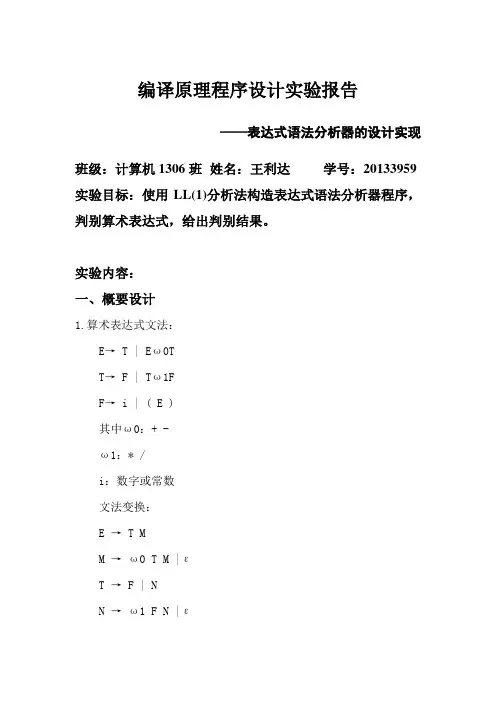
编译原理程序设计实验报告——表达式语法分析器的设计实现班级:计算机1306班姓名:王利达学号:20133959 实验目标:使用LL(1)分析法构造表达式语法分析器程序,判别算术表达式,给出判别结果。
实验内容:一、概要设计1.算术表达式文法:E→ T | Eω0TT→ F | Tω1FF→ i | ( E )其中ω0:+ -ω1:* /i:数字或常数文法变换:E → T MM →ω0 T M |εT → F | NN →ω1 F N |εF → i | ( E )其中ω0:+ -ω1:* /i:数字或常数2.LL(1)分析表表1.LL(1)分析表i + - * / ( ) #E MT,p MT,pM MT,n MT,n ε,p ε,pT NF,p NF,pN NF,n NF,n ε,p ε,pF ε,n )E,n) ε,n# OK二、数据结构1.输入表达式定义char型数组expstr为存放输入表达式的数组,char expstr[100];2.分析栈定义一个栈来进行LL(1)分析。
栈中有bottom、top、stacksize 等元素,用于程序调用栈和对栈操作。
typedef struct //定义语法的栈{SElemType *bottom;//底SElemType *top;//顶int stacksize;}SqStack;(包括:概要设计、数据结构、流程图、关键函数等有选择填写)源程序代码:(加入注释)#include<iostream>#include<stdio.h>#include<cstdlib>using namespace std;#define STACKSIZE 30 //栈大小#define STACKINCREMENT 10 //栈增量#define OK 1#define Error 0#define OVERFLOW -1typedef char SElemType;typedef int Status;int i=0;int count1=0;int count2=0; //计数终结符的个数char expstr[100];typedef struct //定义语法的栈{SElemType *bottom;//底SElemType *top;//顶int stacksize;}SqStack;Status InitStack(SqStack &S) //初始化栈{S.bottom=(SElemType*)malloc(STACKSIZE*sizeof(SElemType));if(!S.bottom)exit(OVERFLOW);S.top=S.bottom;S.stacksize=STACKSIZE;return OK;}Status PUSH(SqStack &S,SElemType e){if(S.top-S.bottom>=S.stacksize){S.bottom=(SElemType*)realloc(S.bottom,(S.stacksize+STACKINCREMENT)*sizeof(SElemType ));if(!S.bottom)exit(OVERFLOW);S.top=S.bottom+S.stacksize;S.stacksize+=STACKINCREMENT;}*(S.top)=e;(S.top)++;return OK;}Status POP(SqStack &S,SElemType &e){if(S.top==S.bottom)return Error;S.top--;e=*(S.top);return OK;}void wrong()//调用此函数,表示出错{cout<<"Wrong!"<<endl;getchar();exit(0);}bool ch_judge(char s[],int n) //字符是否合法{if((s[n]=='(')||(s[n]==')')||(s[n]>='0'&&s[n]<='9')||(s[n]>='a'&&s[n]<='z')||(s[n]=='+')||(s[n]=='-')||(s[ n]=='*')||(s[n]=='/')||(s[n]=='#'))return 1;elsereturn 0;}bool ter_judge(char c) //终结符集合与非终结符集合{if((c=='(')||(c==')')||(c>='0'&&c<='9')||(c>='a'&&c<='z')||(c=='+')||(c=='-')||(c=='*')||(c=='/')) return 1; //终结符返回1else //if(c=='E'||c=='E1'||c=='T'||c=='T1'||c=='F')return 0; //非终结符或#,返回0}bool num_letter(char s[],int i) //判断当前字符是数字还是字母{if((s[i]>='0'&&s[i]<='9')||(s[i]>='a'&&s[i]<='z')){i++;while((s[i]>='0'&&s[i]<='9')||(s[i]>='a'&&s[i]<='z')){i++;count1++;}while(count1!=0){i--;count1--;}i--;return 1; //是字母或数字返回1}elsereturn 0; //不是字母或数字返回0}void LL1(SqStack &S,char s[],int i)//LL1文法分析函数{SElemType e;PUSH(S,'#');PUSH(S,'E');while(s[i]!='#'){if(ch_judge(s,i)){POP(S,e);if(!(ter_judge(e))) //是非终结符{if(e=='#'&&s[i]=='#')break; //表达式正确else if(e=='#'&&s[i]!='#')wrong();else if(e!='#') //分析表匹配{switch(e){case 'E':if(num_letter(s,i)||s[i]=='('){e='M'; // E' MPUSH(S,e);e='T';PUSH(S,e);break;}elsewrong();case 'M':if(s[i]=='+'||s[i]=='-'){e='M';PUSH(S,e);e='T';PUSH(S,e);e=s[i];PUSH(S,e);break;}else if(s[i]==')'||s[i]=='#'){break;}elsewrong();case 'T':if(num_letter(s,i)||s[i]=='('){e='N'; //T' NPUSH(S,e);e='F';PUSH(S,e);break;}elsewrong();case 'N':if(s[i]=='+'||s[i]=='-'||s[i]==')'||s[i]=='#'){break;}else if(s[i]=='*'||s[i]=='/'){e='N';PUSH(S,e);e='F';PUSH(S,e);e=s[i];PUSH(S,e);break;}elsewrong();case 'F':if(num_letter(s,i)){while((s[i]>='0'&&s[i]<='9')||(s[i]>='a'&&s[i]<='z')) //将连续的终结符压栈{e=s[i];PUSH(S,e);i++;count2++; //给连续终结符计数}i--; //使s[i]为连续终结符即一个整数的最后一字break;}else if(s[i]=='('){e=')';PUSH(S,e);e='E';PUSH(S,e);e='(';PUSH(S,e);break;}elsewrong();default:wrong();}}}else{if((s[i]>='0'&&s[i]<='9')||(s[i]>='a'&&s[i]<='z'))//如果是数字或字母则依次计数{while(ter_judge(e)){if(e==s[i]){i--;POP(S,e);}elsewrong();}while(count2!=0){i++;count2--;}PUSH(S,e);i++;}else //如果是+-*/则直接比较{if(e==s[i])i++;elsewrong();}}}elsewrong();}}int main(){SqStack S;InitStack(S);cout<<"LL(1)\nPlease enter the expression and end with the \"#\":"<<endl;cin>>expstr;LL1(S,expstr,i);cout<<"Right! "<<endl;getchar();return 0;}程序运行结果:(截屏)图1.正确的算术表达式(((a+b)*(c/B)))的判断图2.错误的算术表达式a/b++的判断思考问题回答:(如果有)LL(1)分析法和递归下降子程序法在语法分析中同属于自顶向下分析法,LL(1)分析法相对于递归下降子程序法的优势是:LL(1)分析法消除了文法的左递归性,而且克服了回溯,使程序运行的效率大大提升。
实验原理ll1分析法
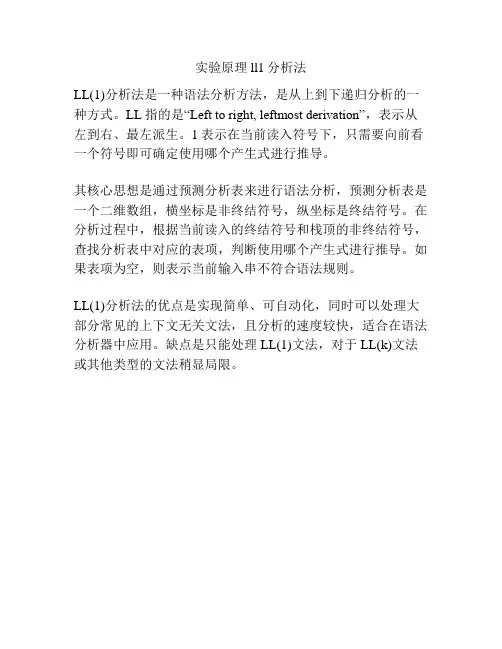
实验原理ll1分析法
LL(1)分析法是一种语法分析方法,是从上到下递归分析的一种方式。
LL指的是“Left to right, leftmost derivation”,表示从左到右、最左派生。
1表示在当前读入符号下,只需要向前看一个符号即可确定使用哪个产生式进行推导。
其核心思想是通过预测分析表来进行语法分析,预测分析表是一个二维数组,横坐标是非终结符号,纵坐标是终结符号。
在分析过程中,根据当前读入的终结符号和栈顶的非终结符号,查找分析表中对应的表项,判断使用哪个产生式进行推导。
如果表项为空,则表示当前输入串不符合语法规则。
LL(1)分析法的优点是实现简单、可自动化,同时可以处理大部分常见的上下文无关文法,且分析的速度较快,适合在语法分析器中应用。
缺点是只能处理LL(1)文法,对于LL(k)文法或其他类型的文法稍显局限。
编译原理实验报告材料LL(1)分析报告法84481
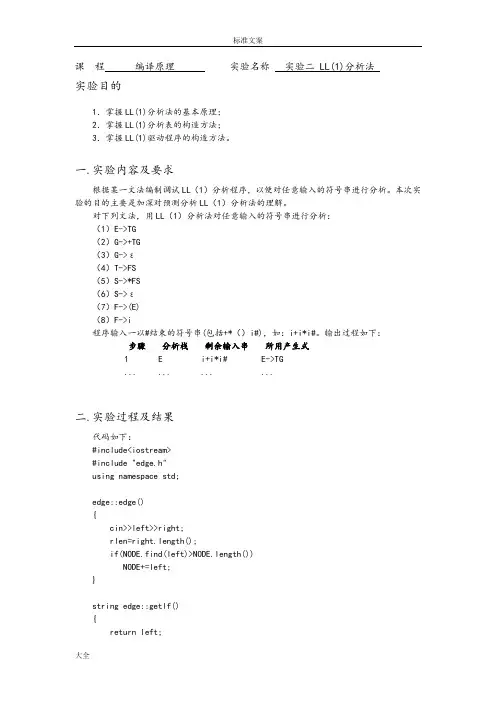
课程编译原理实验名称实验二 LL(1)分析法实验目的1.掌握LL(1)分析法的基本原理;2.掌握LL(1)分析表的构造方法;3.掌握LL(1)驱动程序的构造方法。
一.实验内容及要求根据某一文法编制调试LL(1)分析程序,以便对任意输入的符号串进行分析。
本次实验的目的主要是加深对预测分析LL(1)分析法的理解。
对下列文法,用LL(1)分析法对任意输入的符号串进行分析:(1)E->TG(2)G->+TG(3)G->ε(4)T->FS(5)S->*FS(6)S->ε(7)F->(E)(8)F->i程序输入一以#结束的符号串(包括+*()i#),如:i+i*i#。
输出过程如下:步骤分析栈剩余输入串所用产生式1 E i+i*i# E->TG... ... ... ...二.实验过程及结果代码如下:#include<iostream>#include "edge.h"using namespace std;edge::edge(){cin>>left>>right;rlen=right.length();if(NODE.find(left)>NODE.length())NODE+=left;}string edge::getlf(){return left;}string edge::getrg(){return right;}string edge::getfirst(){return first;}string edge::getfollow(){return follow;}string edge::getselect(){return select;}string edge::getro(){string str;str+=right[0];return str;}int edge::getrlen(){return right.length();}void edge::newfirst(string w){int i;for(i=0;i<w.length();i++)if(first.find(w[i])>first.length())first+=w[i];}void edge::newfollow(string w){int i;for(i=0;i<w.length();i++)if(follow.find(w[i])>follow.length()&&w[i]!='@')follow+=w[i];}void edge::newselect(string w){int i;for(i=0;i<w.length();i++)if(select.find(w[i])>select.length()&&w[i]!='@') select+=w[i];}void edge::delfirst(){int i=first.find('@');first.erase(i,1);}int SUM;string NODE,ENODE;//计算firstvoid first(edge ni,edge *n,int x){int i,j;for(j=0;j<SUM;j++){if(ni.getlf()==n[j].getlf()){if(NODE.find(n[j].getro())<NODE.length()){for(i=0;i<SUM;i++)if(n[i].getlf()==n[j].getro())first(n[i],n,x);}elsen[x].newfirst(n[j].getro());}}}//计算followvoid follow(edge ni,edge *n,int x){int i,j,k,s;string str;for(i=0;i<ni.getrlen();i++){s=NODE.find(ni.getrg()[i]);if(s<NODE.length()&&s>-1) //是非终结符if(i<ni.getrlen()-1) //不在最右for(j=0;j<SUM;j++)if(n[j].getlf().find(ni.getrg()[i])==0){if(NODE.find(ni.getrg()[i+1])<NODE.length()){for(k=0;k<SUM;k++)if(n[k].getlf().find(ni.getrg()[i+1])==0){n[j].newfollow(n[k].getfirst());if(n[k].getfirst().find("@")<n[k].getfirst().length())n[j].newfollow(ni.getfollow());}}else{str.erase();str+=ni.getrg()[i+1];n[j].newfollow(str);}}}}//计算selectvoid select(edge &ni,edge *n){int i,j;if(ENODE.find(ni.getro())<ENODE.length()){ni.newselect(ni.getro());if(ni.getro()=="@")ni.newselect(ni.getfollow());}elsefor(i=0;i<ni.getrlen();i++){for(j=0;j<SUM;j++)if(ni.getrg()[i]==n[j].getlf()[0]){ni.newselect(n[j].getfirst());if(n[j].getfirst().find('@')>n[j].getfirst().length())return;}}}//输出集合void out(string p){int i;if(p.length()==0)return;cout<<"{";for(i=0;i<p.length()-1;i++){cout<<p[i]<<",";}cout<<p[i]<<"}";}//连续输出符号void outfu(int a,string c){int i;for(i=0;i<a;i++)cout<<c;}//输出预测分析表void outgraph(edge *n,string (*yc)[50]){int i,j,k;bool flag;for(i=0;i<ENODE.length();i++){if(ENODE[i]!='@'){outfu(10," ");cout<<ENODE[i];}}outfu(10," ");cout<<"#"<<endl;int x;for(i=0;i<NODE.length();i++){outfu(4," ");cout<<NODE[i];outfu(5," ");for(k=0;k<ENODE.length();k++){flag=1;for(j=0;j<SUM;j++){if(NODE[i]==n[j].getlf()[0]){x=n[j].getselect().find(ENODE[k]);if(x<n[j].getselect().length()&&x>-1){cout<<"->"<<n[j].getrg();yc[i][k]=n[j].getrg();outfu(9-n[j].getrlen()," ");flag=0;}x=n[j].getselect().find('#');if(k==ENODE.length()-1&&x<n[j].getselect().length()&&x>-1){cout<<"->"<<n[j].getrg();yc[i][j]=n[j].getrg();}}}if(flag&&ENODE[k]!='@')outfu(11," ");}cout<<endl;}}//分析符号串int pipei(string &chuan,string &fenxi,string (*yc)[50],int &b) {char ch,a;int x,i,j,k;b++;cout<<endl<<" "<<b;if(b>9)outfu(8," ");elseoutfu(9," ");cout<<fenxi;outfu(26-chuan.length()-fenxi.length()," "); cout<<chuan;outfu(10," ");a=chuan[0];ch=fenxi[fenxi.length()-1];x=ENODE.find(ch);if(x<ENODE.length()&&x>-1){if(ch==a){fenxi.erase(fenxi.length()-1,1);chuan.erase(0,1);cout<<"'"<<a<<"'匹配";if(pipei(chuan,fenxi,yc,b))return 1;elsereturn 0;}elsereturn 0;}else{if(ch=='#'){if(ch==a){cout<<"分析成功"<<endl;return 1;}elsereturn 0;}elseif(ch=='@'){fenxi.erase(fenxi.length()-1,1);if(pipei(chuan,fenxi,yc,b))return 1;elsereturn 0;}else{i=NODE.find(ch);if(a=='#'){x=ENODE.find('@');if(x<ENODE.length()&&x>-1)j=ENODE.length()-1;elsej=ENODE.length();}elsej=ENODE.find(a);if(yc[i][j].length()){cout<<NODE[i]<<"->"<<yc[i][j];fenxi.erase(fenxi.length()-1,1);for(k=yc[i][j].length()-1;k>-1;k--)if(yc[i][j][k]!='@')fenxi+=yc[i][j][k];if(pipei(chuan,fenxi,yc,b))return 1;elsereturn 0;}elsereturn 0;}}}void main(){edge *n;string str,(*yc)[50];int i,j,k;bool flag=0;cout<<"请输入上下文无关文法的总规则数:"<<endl;cin>>SUM;cout<<"请输入具体规则(格式:左部右部,@为空):"<<endl;n=new edge[SUM];for(i=0;i<SUM;i++)for(j=0;j<n[i].getrlen();j++){str=n[i].getrg();if(NODE.find(str[j])>NODE.length()&&ENODE.find(str[j])>ENODE.length()) ENODE+=str[j];}//计算first集合for(i=0;i<SUM;i++){first(n[i],n,i);}//outfu(10,"~*~");cout<<endl;for(i=0;i<SUM;i++)if(n[i].getfirst().find("@")<n[i].getfirst().length()){if(NODE.find(n[i].getro())<NODE.length()){for(k=1;k<n[i].getrlen();k++){if(NODE.find(n[i].getrg()[k])<NODE.length()){for(j=0;j<SUM;j++){if(n[i].getrg()[k]==n[j].getlf()[0]){n[i].newfirst(n[j].getfirst());break;}}if(n[j].getfirst().find("@")>n[j].getfirst().length()){n[i].delfirst();break;}}}}}//计算follow集合for(k=0;k<SUM;k++){for(i=0;i<SUM;i++){if(n[i].getlf()==n[0].getlf())n[i].newfollow("#");follow(n[i],n,i);}for(i=0;i<SUM;i++){for(j=0;j<SUM;j++)if(n[j].getrg().find(n[i].getlf())==n[j].getrlen()-1)n[i].newfollow(n[j].getfollow());}}//计算select集合for(i=0;i<SUM;i++){select(n[i],n);}for(i=0;i<NODE.length();i++){str.erase();for(j=0;j<SUM;j++)if(n[j].getlf()[0]==NODE[i]){if(!str.length())str=n[j].getselect();else{for(k=0;k<n[j].getselect().length();k++)if(str.find(n[j].getselect()[k])<str.length()){flag=1;break;}}}}//输出cout<<endl<<"非终结符";outfu(SUM," ");cout<<"First";outfu(SUM," ");cout<<"Follow"<<endl;outfu(5+SUM,"-*-");cout<<endl;for(i=0;i<NODE.length();i++){for(j=0;j<SUM;j++)if(NODE[i]==n[j].getlf()[0]){outfu(3," ");cout<<NODE[i];outfu(SUM+4," ");out(n[j].getfirst());outfu(SUM+4-2*n[j].getfirst().length()," ");out(n[j].getfollow());cout<<endl;break;}}outfu(5+SUM,"-*-");cout<<endl<<"判定结论: ";if(flag){cout<<"该文法不是LL(1)文法!"<<endl;return;}else{cout<<"该文法是LL(1)文法!"<<endl;}//输出预测分析表cout<<endl<<"预测分析表如下:"<<endl;yc=new string[NODE.length()][50];outgraph(n,yc);string chuan,fenxi,fchuan;cout<<endl<<"请输入符号串:";cin>>chuan;fchuan=chuan;fenxi="#";fenxi+=NODE[0];i=0;cout<<endl<<"预测分析过程如下:"<<endl;cout<<"步骤";outfu(7," ");cout<<"分析栈";outfu(10," ");cout<<"剩余输入串";outfu(8," ");cout<<"推导所用产生式或匹配";if(pipei(chuan,fenxi,yc,i))cout<<endl<<"输入串"<<fchuan<<"是该文法的句子!"<<endl;elsecout<<endl<<"输入串"<<fchuan<<"不是该文法的句子!"<<endl;}截屏如下:三.实验中的问题及心得这次实验让我更加熟悉了LL(1)的工作流程以及LL(1)分析表的构造方法。
LL(1)分析法
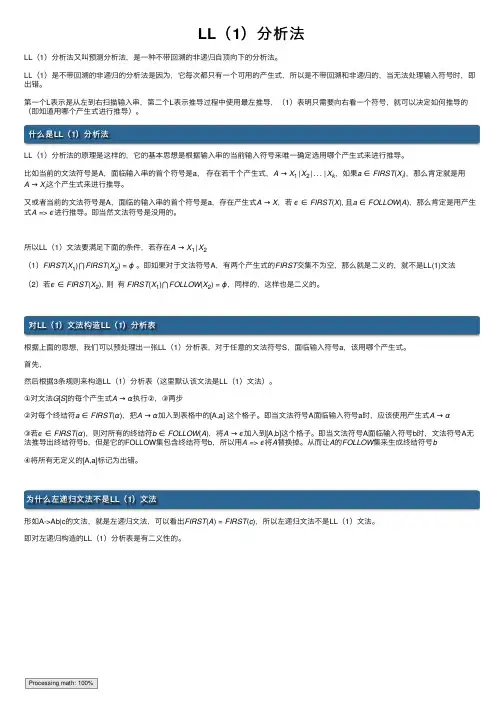
LL(1)分析法LL(1)分析法⼜叫预测分析法,是⼀种不带回溯的⾮递归⾃顶向下的分析法。
LL(1)是不带回溯的⾮递归的分析法是因为,它每次都只有⼀个可⽤的产⽣式,所以是不带回溯和⾮递归的,当⽆法处理输⼊符号时,即出错。
第⼀个L表⽰是从左到右扫描输⼊串,第⼆个L表⽰推导过程中使⽤最左推导,(1)表明只需要向右看⼀个符号,就可以决定如何推导的(即知道⽤哪个产⽣式进⾏推导)。
什么是LL(1)分析法LL(1)分析法的原理是这样的,它的基本思想是根据输⼊串的当前输⼊符号来唯⼀确定选⽤哪个产⽣式来进⾏推导。
⽐如当前的⽂法符号是A,⾯临输⼊串的⾸个符号是a,存在若⼲个产⽣式,A→X1|X2|...|X k,如果a∈FIRST(X i),那么肯定就是⽤A→X i这个产⽣式来进⾏推导。
⼜或者当前的⽂法符号是A,⾯临的输⼊串的⾸个符号是a,存在产⽣式A→X,若ϵ∈FIRST(X), 且a∈FOLLOW(A),那么肯定是⽤产⽣式A=>ϵ进⾏推导。
即当然⽂法符号是没⽤的。
所以LL(1)⽂法要满⾜下⾯的条件,若存在A→X1|X2(1)FIRST(X1)⋂FIRST(X2)=ϕ。
即如果对于⽂法符号A,有两个产⽣式的FIRST交集不为空,那么就是⼆义的,就不是LL(1)⽂法(2)若ϵ∈FIRST(X2),则有FIRST(X1)⋂FOLLOW(X2)=ϕ,同样的,这样也是⼆义的。
对LL(1)⽂法构造LL(1)分析表根据上⾯的思想,我们可以预处理出⼀张LL(1)分析表,对于任意的⽂法符号S,⾯临输⼊符号a,该⽤哪个产⽣式。
⾸先,然后根据3条规则来构造LL(1)分析表(这⾥默认该⽂法是LL(1)⽂法)。
①对⽂法G[S]的每个产⽣式A→α执⾏②,③两步②对每个终结符a∈FIRST(α),把A→α加⼊到表格中的[A,a] 这个格⼦。
即当⽂法符号A⾯临输⼊符号a时,应该使⽤产⽣式A→α③若ϵ∈FIRST(α),则对所有的终结符b∈FOLLOW(A),将A→ϵ加⼊到[A,b]这个格⼦。
编译原理课程设计报告——LL(1)分析
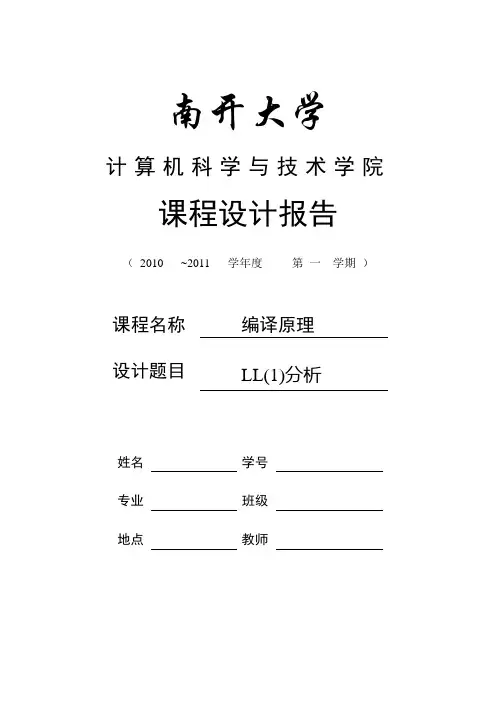
南开大学计算机科学与技术学院课程设计报告(2010 ~2011 学年度第一学期)课程名称编译原理设计题目LL(1)分析姓名学号专业班级地点教师1.需求分析语法分析是编译过程的核心部分。
它的任务是在词法分析识别出单词符号串的基础上,分析并判定程序的语法结构是否符合语法规则。
语法分析器在编译程序中的地位如图1所示:图1 语法分析器在编译程序中的地位语言的语法结构是用上下文无关文法描述的。
因此,语法分析器的工作本质上就是按文法的产生式,识别输入符号串是否为一个句子。
这里所说的输入串是指由单词符号(文法的终结符)组成的有限序列。
对一个文法,当给你一串(终结)符号时,怎样知道它是不是该文法的一个句子呢?这就要判断,看是否能从文法的开始符号出发推导出这个输入串。
或者,从概念上讲,就是要建立一棵与输入串相匹配的语法分析树。
自顶向下分析法就是语法分析办法中的一类。
顾名思义,自顶向下就是从文法的开始符号出发,向下推导,推出句子。
这种方法是带“回溯”的。
自顶向下分析的主旨是,对任何输入串,试图用一切可能的办法,从文法开始符号(根结)出发,自上而下地为输入串建立一棵语法树。
或者说,为输入串寻找一个最左推导。
这种分析过程本质上是一种试探过程,是反复使用不同产生式谋求匹配输入串的过程。
实现这种自顶向下的带回溯试探法的一个简单途径是让每个非终结符对应一个递归子程序。
每个这种子程序可作为一个布尔过程。
一旦发现它的某个候选与输入串相匹配,就用这个候选去扩展语法树,并返回“真”值;否则,保持原来的语法树和IP值不变,并返回“假”值。
对于给定的分析文法对象,构造它的预测分析程序;并任意给一算术表达式进行分析测试,本预测分析程序能够使用分析表和栈联合控制实现LL(1)分析,本文将就编译原理中比较常用的一个表达式文法,通过递归下降语法分析法来编写分析器。
文中将为您提供如何通过FIRST、FOLLOW和SELECT集合来判断LL(1)方法,然后如何用递归下降语法分析法分析LL(1)方法的基本递归流程,以及用C++语言来编程实现分析器。
【编译原理】语法分析LL(1)分析法的FIRST和FOLLOW集
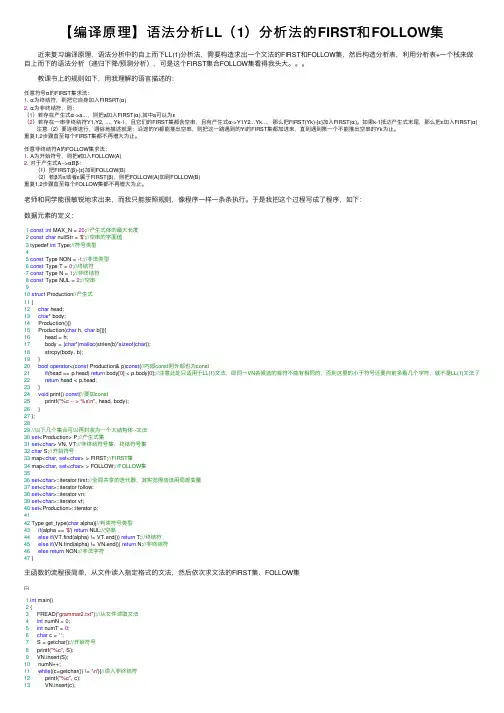
【编译原理】语法分析LL(1)分析法的FIRST和FOLLOW集 近来复习编译原理,语法分析中的⾃上⽽下LL(1)分析法,需要构造求出⼀个⽂法的FIRST和FOLLOW集,然后构造分析表,利⽤分析表+⼀个栈来做⾃上⽽下的语法分析(递归下降/预测分析),可是这个FIRST集合FOLLOW集看得我头⼤。
教课书上的规则如下,⽤我理解的语⾔描述的:任意符号α的FIRST集求法:1. α为终结符,则把它⾃⾝加⼊FIRSRT(α)2. α为⾮终结符,则:(1)若存在产⽣式α->a...,则把a加⼊FIRST(α),其中a可以为ε(2)若存在⼀串⾮终结符Y1,Y2, ..., Yk-1,且它们的FIRST集都含空串,且有产⽣式α->Y1Y2...Yk...,那么把FIRST(Yk)-{ε}加⼊FIRST(α)。
如果k-1抵达产⽣式末尾,那么把ε加⼊FIRST(α) 注意(2)要连续进⾏,通俗地描述就是:沿途的Yi都能推出空串,则把这⼀路遇到的Yi的FIRST集都加进来,直到遇到第⼀个不能推出空串的Yk为⽌。
重复1,2步骤直⾄每个FIRST集都不再增⼤为⽌。
任意⾮终结符A的FOLLOW集求法:1. A为开始符号,则把#加⼊FOLLOW(A)2. 对于产⽣式A-->αBβ: (1)把FIRST(β)-{ε}加到FOLLOW(B) (2)若β为ε或者ε属于FIRST(β),则把FOLLOW(A)加到FOLLOW(B)重复1,2步骤直⾄每个FOLLOW集都不再增⼤为⽌。
⽼师和同学能很敏锐地求出来,⽽我只能按照规则,像程序⼀样⼀条条执⾏。
于是我把这个过程写成了程序,如下:数据元素的定义:1const int MAX_N = 20;//产⽣式体的最⼤长度2const char nullStr = '$';//空串的字⾯值3 typedef int Type;//符号类型45const Type NON = -1;//⾮法类型6const Type T = 0;//终结符7const Type N = 1;//⾮终结符8const Type NUL = 2;//空串910struct Production//产⽣式11 {12char head;13char* body;14 Production(){}15 Production(char h, char b[]){16 head = h;17 body = (char*)malloc(strlen(b)*sizeof(char));18 strcpy(body, b);19 }20bool operator<(const Production& p)const{//内部const则外部也为const21if(head == p.head) return body[0] < p.body[0];//注意此处只适⽤于LL(1)⽂法,即同⼀VN各候选的⾸符不能有相同的,否则这⾥的⼩于符号还要向前多看⼏个字符,就不是LL(1)⽂法了22return head < p.head;23 }24void print() const{//要加const25 printf("%c -- > %s\n", head, body);26 }27 };2829//以下⼏个集合可以再封装为⼀个⼤结构体--⽂法30set<Production> P;//产⽣式集31set<char> VN, VT;//⾮终结符号集,终结符号集32char S;//开始符号33 map<char, set<char> > FIRST;//FIRST集34 map<char, set<char> > FOLLOW;//FOLLOW集3536set<char>::iterator first;//全局共享的迭代器,其实觉得应该⽤局部变量37set<char>::iterator follow;38set<char>::iterator vn;39set<char>::iterator vt;40set<Production>::iterator p;4142 Type get_type(char alpha){//判读符号类型43if(alpha == '$') return NUL;//空串44else if(VT.find(alpha) != VT.end()) return T;//终结符45else if(VN.find(alpha) != VN.end()) return N;//⾮终结符46else return NON;//⾮法字符47 }主函数的流程很简单,从⽂件读⼊指定格式的⽂法,然后依次求⽂法的FIRST集、FOLLOW集1int main()2 {3 FREAD("grammar2.txt");//从⽂件读取⽂法4int numN = 0;5int numT = 0;6char c = '';7 S = getchar();//开始符号8 printf("%c", S);9 VN.insert(S);10 numN++;11while((c=getchar()) != '\n'){//读⼊⾮终结符12 printf("%c", c);13 VN.insert(c);14 numN++;15 }16 pn();17while((c=getchar()) != '\n'){//读⼊终结符18 printf("%c", c);19 VT.insert(c);20 numT++;21 }22 pn();23 REP(numN){//读⼊产⽣式24 c = getchar();25int n; RINT(n);26while(n--){27char body[MAX_N];28 scanf("%s", body);29 printf("%c --> %s\n", c, body);30 P.insert(Production(c, body));31 }32 getchar();33 }3435 get_first();//⽣成FIRST集36for(vn = VN.begin(); vn != VN.end(); vn++){//打印⾮终结符的FIRST集37 printf("FIRST(%c) = { ", *vn);38for(first = FIRST[*vn].begin(); first != FIRST[*vn].end(); first++){39 printf("%c, ", *first);40 }41 printf("}\n");42 }4344 get_follow();//⽣成⾮终结符的FOLLOW集45for(vn = VN.begin(); vn != VN.end(); vn++){//打印⾮终结符的FOLLOW集46 printf("FOLLOW(%c) = { ", *vn);47for(follow = FOLLOW[*vn].begin(); follow != FOLLOW[*vn].end(); follow++){48 printf("%c, ", *follow);49 }50 printf("}\n");51 }52return0;53 }主函数其中⽂法⽂件的数据格式为(按照平时做题的输⼊格式设计的):第⼀⾏:所有⾮终结符,⽆空格,第⼀个为开始符号;第⼆⾏:所有终结符,⽆空格;剩余⾏:每⾏描述了⼀个⾮终结符的所有产⽣式,第⼀个字符为产⽣式头(⾮终结符),后跟⼀个整数位候选式的个数n,之后是n个以空格分隔的字符串为产⽣式体。
编译原理实验报告《ll(1)语法分析器构造》
规则右部首符号是终结
符
.
.
{ first[r].append(1,a); break;// 添加并结束
}
if(U.find(P[i][j])!=string::npos)// 规则右部首符号是非终结符 ,形如 X:: =Y1Y2...Yk
{
s=U.find(P[i][ j]);
//cout<<P[i][ j]<<":\n";
arfa=beta=""; for( j=0;j<100&&P[j][0]!=' ';j++) {
if(P[ j][0]==U[i]) {
if(P[ j][4]==U[i])// 产生式 j 有左递归 {
flagg=1;
.
.
for(temp=5;P[j][temp]!=' ';temp++) arfa.append(1,P[
{
int i,j,r,s,tmp;
string* first=new string[n];
char a;
int step=100;// 最大推导步数
while(step--){
// cout<<"step"<<100-step<<endl;
for(i=0;i<k;i++)
{
//cout<<P[i]<<endl;
j][temp]);
if(P[ j+1][4]==U[i]) arfa.append("|");//
编译原理实验报告LL(1)分析法
编译原理实验报告LL(1)分析法课程编译原理实验名称实验二 LL(1)分析法实验目的1.掌握LL(1)分析法的基本原理;2.掌握LL(1)分析表的构造方法;3.掌握LL(1)驱动程序的构造方法。
一.实验内容及要求根据某一文法编制调试LL(1)分析程序,以便对任意输入的符号串进行分析。
本次实验的目的主要是加深对预测分析LL(1)分析法的理解。
对下列文法,用LL(1)分析法对任意输入的符号串进行分析:(1)E->TG(2)G->+TG(3)G->ε(4)T->FS(5)S->*FS(6)S->ε(7)F->(E)(8)F->i程序输入一以#结束的符号串(包括+*()i#),如:i+i*i#。
输出过程如下:步骤分析栈剩余输入串所用产生式1 E i+i*i# E->TG... ... ... ...二.实验过程及结果代码如下:#include#include "edge.h"using namespace std;edge::edge(){cin>>left>>right;rlen=right.length();if(NODE.find(left)>NODE.length()) NODE+=left;}string edge::getlf(){return left;}string edge::getrg(){return right;}string edge::getfirst(){return first;}string edge::getfollow(){return follow;}string edge::getselect(){return select;}string edge::getro(){string str;str+=right[0];return str;}int edge::getrlen(){return right.length();}void edge::newfirst(string w){int i;for(i=0;iif(first.find(w[i])>first.length())first+=w[i];}void edge::newfollow(string w){int i;for(i=0;iif(follow.find(w[i])>follow.length()&&w[i]!='@')follow+=w[i];}void edge::newselect(string w){int i;for(i=0;iif(select.find(w[i])>select.length()&&w[i]!='@') select+=w[i];}void edge::delfirst(){int i=first.find('@');first.erase(i,1);}int SUM;string NODE,ENODE;//计算firstvoid first(edge ni,edge *n,int x){int i,j;for(j=0;j{if(ni.getlf()==n[j].getlf()){if(NODE.find(n[j].getro()){for(i=0;iif(n[i].getlf()==n[j].getro())first(n[i],n,x);}elsen[x].newfirst(n[j].getro());}}}//计算followvoid follow(edge ni,edge *n,int x){int i,j,k,s;string str;for(i=0;i{s=NODE.find(ni.getrg()[i]);if(s-1) //是非终结符if(ifor(j=0;jif(n[j].getlf().find(ni.getrg()[i])==0) {if(NODE.find(ni.getrg()[i+1]){for(k=0;kif(n[k].getlf().find(ni.getrg()[i+1])==0) {n[j].newfollow(n[k].getfirst());if(n[k].getfirst().find("@")n[j].newfollow(ni.getfollow());}}else{str.erase();str+=ni.getrg()[i+1];n[j].newfollow(str);}}}}//计算selectvoid select(edge &ni,edge *n){int i,j;if(ENODE.find(ni.getro()){ni.newselect(ni.getro());if(ni.getro()=="@")ni.newselect(ni.getfollow());}elsefor(i=0;i{for(j=0;jif(ni.getrg()[i]==n[j].getlf()[0]){ni.newselect(n[j].getfirst());if(n[j].getfirst().find('@')>n[j].getfirst().length()) return;}}}//输出集合void out(string p){int i;if(p.length()==0)return;coutfor(i=0;i{cout}cout}//连续输出符号void outfu(int a,string c){int i;for(i=0;icout}//输出预测分析表void outgraph(edge *n,string (*yc)[50]) {int i,j,k;bool flag;for(i=0;i{if(ENODE[i]!='@'){outfu(10," ");cout}}outfu(10," ");coutint x;for(i=0;i{outfu(4," ");coutoutfu(5," ");for(k=0;k{flag=1;for(j=0;j{if(NODE[i]==n[j].getlf()[0]){x=n[j].getselect().find(ENODE[k]); if(x-1){cout"yc[i][k]=n[j].getrg();outfu(9-n[j].getrlen()," ");flag=0;}x=n[j].getselect().find('#');if(k==ENODE.length()-1&&x-1) {cout"yc[i][j]=n[j].getrg();}}}if(flag&&ENODE[k]!='@')outfu(11," ");}cout}}//分析符号串int pipei(string &chuan,string &fenxi,string (*yc)[50],int &b){char ch,a;int x,i,j,k; b++; cout9) outfu(8," "); else outfu(9," "); cout-1) { if(ch==a) { fenxi.erase(fenxi.length()-1,1); chuan.erase(0,1); coutfenxi.erase(fenxi.length()-1,1); if(pipei(chuan,fenxi,yc,b)) return 1;elsereturn 0;}else{i=NODE.find(ch);if(a=='#'){x=ENODE.find('@');if(x-1) j=ENODE.length()-1; elsej=ENODE.length();}elsej=ENODE.find(a);if(yc[i][j].length()){cout"-1;k--) if(yc[i][j][k]!='@')fenxi+=yc[i][j][k];if(pipei(chuan,fenxi,yc,b)) return 1; elsereturn 0;}elsereturn 0;}}}void main(){edge *n;string str,(*yc)[50];int i,j,k;bool flag=0;cin>>SUM; coutNODE.length()&&ENODE.find(str[j])>ENODE.length())ENODE+=str[j]; } //计算first集合 for(i=0;in[j].getfirst().length()){ n[i].delfirst(); break; } } } } }for(k=0;koutfu(SUM," "); cout>chuan; fchuan=chuan; fenxi="#"; fenxi+=NODE[0]; i=0; coutoutfu(7," ");coutoutfu(10," ");coutoutfu(8," ");coutif(pipei(chuan,fenxi,yc,i))coutelsecout}截屏如下:三.实验中的问题及心得这次实验让我更加熟悉了LL(1)的工作流程以及LL(1)分析表的构造方法。
编译原理实验二LL(1)语法分析实验报告
专题3_LL(1)语法分析设计原理与实现李若森 13281132 计科1301一、理论传授语法分析的设计方法和实现原理;LL(1) 分析表的构造;LL(1)分析过程;LL(1)分析器的构造。
二、目标任务实验项目实现LL(1)分析中控制程序(表驱动程序);完成以下描述算术表达式的 LL(1)文法的LL(1)分析程序。
G[E]:E→TE’E’→ATE’|εT→FT’T’→MFT’|εF→(E)|iA→+|-M→*|/设计说明终结符号i为用户定义的简单变量,即标识符的定义。
加减乘除即运算符。
设计要求(1)输入串应是词法分析的输出二元式序列,即某算术表达式“专题 1”的输出结果,输出为输入串是否为该文法定义的算术表达式的判断结果;(2)LL(1)分析程序应能发现输入串出错;(3)设计两个测试用例(尽可能完备,正确和出错),并给出测试结果。
任务分析重点解决LL(1)表的构造和LL(1)分析器的实现。
三、实现过程实现LL(1)分析器a)将#号放在输入串S的尾部b)S中字符顺序入栈c)反复执行c),任何时候按栈顶Xm和输入ai依据分析表,执行下述三个动作之一。
构造LL(1)分析表构造LL(1)分析表需要得到文法G[E]的FIRST集和FOLLOW集。
构造FIRST(α)构造FOLLOW(A)构造LL(1)分析表算法根据上述算法可得G[E]的LL(1)分析表,如表3-1所示:表3-1 LL(1)分析表主要数据结构pair<int, string>:用pair<int, string>来存储单个二元组。
该对照表由专题1定义。
map<string, int>:存储离散化后的终结符和非终结符。
vector<string>[][]:存储LL(1)分析表函数定义init:void init();功能:初始化LL(1)分析表,关键字及识别码对照表,离散化(非)终结符传入参数:(无)传出参数:(无)返回值:(无)Parse:bool Parse( const vector<PIS> &vec, int &ncol );功能:进行该行的语法分析传入参数:vec:该行二元式序列传出参数:emsg:出错信息epos:出错标识符首字符所在位置返回值:是否成功解析。
编译原理实验报告分析法
工业大学实验报告课程编译原理实验名称实验二LL(1)分析法实验目的1.掌握LL(1)分析法的基本原理;2.掌握LL(1)分析表的构造法;3.掌握LL(1)驱动程序的构造法。
一.实验容及要求根据某一文法编制调试LL(1)分析程序,以便对任意输入的符号串进行分析。
本次实验的目的主要是加深对预测分析LL(1)分析法的理解。
对下列文法,用LL(1)分析法对任意输入的符号串进行分析:(1)E->TG(2)G->+TG(3)G->ε(4)T->FS(5)S->*FS(6)S->ε(7)F->(E)(8)F->i程序输入一以#结束的符号串(包括+*()i#),如:i+i*i#。
输出过程如下:步骤分析栈剩余输入串所用产生式1 E i+i*i# E->TG... ... ... ...二.实验过程及结果代码如下:#include<iostream>#include "edge.h"using namespace std;edge::edge(){cin>>left>>right;rlen=right.length();if(NODE.find(left)>NODE.length())NODE+=left;}string edge::getlf(){return left;}string edge::getrg(){return right;}string edge::getfirst(){return first;}string edge::getfollow(){return follow;}string edge::getselect(){return select;}string edge::getro(){string str;str+=right[0];return str;}int edge::getrlen(){return right.length();}void edge::newfirst(string w){int i;for(i=0;i<w.length();i++)if(first.find(w[i])>first.length())first+=w[i];void edge::newfollow(string w){int i;for(i=0;i<w.length();i++)if(follow.find(w[i])>follow.length()&&w[i]!='@')follow+=w[i];}void edge::newselect(string w){int i;for(i=0;i<w.length();i++)if(select.find(w[i])>select.length()&&w[i]!='@')select+=w[i];}void edge::delfirst(){int i=first.find('@');first.erase(i,1);}int SUM;string NODE,ENODE;//计算firstvoid first(edge ni,edge *n,int x){int i,j;for(j=0;j<SUM;j++){if(ni.getlf()==n[j].getlf()){if(NODE.find(n[j].getro())<NODE.length()){for(i=0;i<SUM;i++)if(n[i].getlf()==n[j].getro())first(n[i],n,x);}elsen[x].newfirst(n[j].getro());}}//计算followvoid follow(edge ni,edge *n,int x){int i,j,k,s;string str;for(i=0;i<ni.getrlen();i++){s=NODE.find(ni.getrg()[i]);if(s<NODE.length()&&s>-1) //是非终结符if(i<ni.getrlen()-1) //不在最右for(j=0;j<SUM;j++)if(n[j].getlf().find(ni.getrg()[i])==0){if(NODE.find(ni.getrg()[i+1])<NODE.length()){for(k=0;k<SUM;k++)if(n[k].getlf().find(ni.getrg()[i+1])==0){n[j].newfollow(n[k].getfirst());if(n[k].getfirst().find("@")<n[k].getfirst().length())n[j].newfollow(ni.getfollow());}}else{str.erase();str+=ni.getrg()[i+1];n[j].newfollow(str);}}}}//计算selectvoid select(edge &ni,edge *n){int i,j;if(ENODE.find(ni.getro())<ENODE.length()){ni.newselect(ni.getro());if(ni.getro()=="@")ni.newselect(ni.getfollow());}elsefor(i=0;i<ni.getrlen();i++){for(j=0;j<SUM;j++)if(ni.getrg()[i]==n[j].getlf()[0]){ni.newselect(n[j].getfirst());if(n[j].getfirst().find('@')>n[j].getfirst().length())return;}}}//输出集合void out(string p){int i;if(p.length()==0)return;cout<<"{";for(i=0;i<p.length()-1;i++){cout<<p[i]<<",";}cout<<p[i]<<"}";}//连续输出符号void outfu(int a,string c){int i;for(i=0;i<a;i++)cout<<c;}//输出预测分析表void outgraph(edge *n,string (*yc)[50]){int i,j,k;bool flag;for(i=0;i<ENODE.length();i++){if(ENODE[i]!='@'){outfu(10," ");cout<<ENODE[i];}}outfu(10," ");cout<<"#"<<endl;int x;for(i=0;i<NODE.length();i++){outfu(4," ");cout<<NODE[i];outfu(5," ");for(k=0;k<ENODE.length();k++){flag=1;for(j=0;j<SUM;j++){if(NODE[i]==n[j].getlf()[0]){x=n[j].getselect().find(ENODE[k]);if(x<n[j].getselect().length()&&x>-1){cout<<"->"<<n[j].getrg();yc[i][k]=n[j].getrg();outfu(9-n[j].getrlen()," ");flag=0;}x=n[j].getselect().find('#');if(k==ENODE.length()-1&&x<n[j].getselect().length()&&x>-1){cout<<"->"<<n[j].getrg();yc[i][j]=n[j].getrg();}}}if(flag&&ENODE[k]!='@')outfu(11," ");}cout<<endl;}}//分析符号串int pipei(string &chuan,string &fenxi,string (*yc)[50],int &b) {char ch,a;int x,i,j,k;b++;cout<<endl<<" "<<b;if(b>9)outfu(8," ");elseoutfu(9," ");cout<<fenxi;outfu(26-chuan.length()-fenxi.length()," ");cout<<chuan;outfu(10," ");a=chuan[0];ch=fenxi[fenxi.length()-1];x=ENODE.find(ch);if(x<ENODE.length()&&x>-1){if(ch==a){fenxi.erase(fenxi.length()-1,1);chuan.erase(0,1);cout<<"'"<<a<<"'匹配";if(pipei(chuan,fenxi,yc,b))return 1;elsereturn 0;}elsereturn 0;}else{if(ch=='#'){if(ch==a){cout<<"分析成功"<<endl;return 1;}elsereturn 0;}elseif(ch=='@'){fenxi.erase(fenxi.length()-1,1);if(pipei(chuan,fenxi,yc,b))return 1;elsereturn 0;}else{i=NODE.find(ch);if(a=='#'){x=ENODE.find('@');if(x<ENODE.length()&&x>-1)j=ENODE.length()-1;elsej=ENODE.length();}elsej=ENODE.find(a);if(yc[i][j].length()){cout<<NODE[i]<<"->"<<yc[i][j];fenxi.erase(fenxi.length()-1,1);for(k=yc[i][j].length()-1;k>-1;k--)if(yc[i][j][k]!='@')fenxi+=yc[i][j][k];if(pipei(chuan,fenxi,yc,b))return 1;elsereturn 0;}elsereturn 0;}}}void main(){edge *n;string str,(*yc)[50];int i,j,k;bool flag=0;cout<<"请输入上下文无关文法的总规则数:"<<endl;cin>>SUM;cout<<"请输入具体规则(格式:左部右部,@为空):"<<endl;n=new edge[SUM];for(i=0;i<SUM;i++)for(j=0;j<n[i].getrlen();j++){str=n[i].getrg();if(NODE.find(str[j])>NODE.length()&&ENODE.find(str[j])>ENODE.length()) ENODE+=str[j];}//计算first集合for(i=0;i<SUM;i++){first(n[i],n,i);}//outfu(10,"~*~");cout<<endl;for(i=0;i<SUM;i++)if(n[i].getfirst().find("@")<n[i].getfirst().length()){if(NODE.find(n[i].getro())<NODE.length()){for(k=1;k<n[i].getrlen();k++){if(NODE.find(n[i].getrg()[k])<NODE.length()){for(j=0;j<SUM;j++){if(n[i].getrg()[k]==n[j].getlf()[0]){n[i].newfirst(n[j].getfirst());break;}}if(n[j].getfirst().find("@")>n[j].getfirst().length()){n[i].delfirst();break;}}}}}//计算follow集合for(k=0;k<SUM;k++){for(i=0;i<SUM;i++){if(n[i].getlf()==n[0].getlf())n[i].newfollow("#");follow(n[i],n,i);}for(i=0;i<SUM;i++){for(j=0;j<SUM;j++)if(n[j].getrg().find(n[i].getlf())==n[j].getrlen()-1)n[i].newfollow(n[j].getfollow());}}//计算select集合for(i=0;i<SUM;i++){select(n[i],n);}for(i=0;i<NODE.length();i++){str.erase();for(j=0;j<SUM;j++)if(n[j].getlf()[0]==NODE[i]){if(!str.length())str=n[j].getselect();else{for(k=0;k<n[j].getselect().length();k++)if(str.find(n[j].getselect()[k])<str.length()){flag=1;break;}}}}//输出cout<<endl<<"非终结符";outfu(SUM," ");cout<<"First";outfu(SUM," ");cout<<"Follow"<<endl;outfu(5+SUM,"-*-");cout<<endl;for(i=0;i<NODE.length();i++){for(j=0;j<SUM;j++)if(NODE[i]==n[j].getlf()[0]){outfu(3," ");cout<<NODE[i];outfu(SUM+4," ");out(n[j].getfirst());outfu(SUM+4-2*n[j].getfirst().length()," ");out(n[j].getfollow());cout<<endl;break;}}outfu(5+SUM,"-*-");cout<<endl<<"判定结论:";if(flag){cout<<"该文法不是LL(1)文法!"<<endl;return;}else{cout<<"该文法是LL(1)文法!"<<endl;}//输出预测分析表cout<<endl<<"预测分析表如下:"<<endl;yc=new string[NODE.length()][50];outgraph(n,yc);string chuan,fenxi,fchuan;cout<<endl<<"请输入符号串:";cin>>chuan;fchuan=chuan;fenxi="#";fenxi+=NODE[0];i=0;cout<<endl<<"预测分析过程如下:"<<endl;cout<<"步骤";outfu(7," ");cout<<"分析栈";outfu(10," ");cout<<"剩余输入串";outfu(8," ");cout<<"推导所用产生式或匹配";if(pipei(chuan,fenxi,yc,i))cout<<endl<<"输入串"<<fchuan<<"是该文法的句子!"<<endl;elsecout<<endl<<"输入串"<<fchuan<<"不是该文法的句子!"<<endl;}截屏如下:三.实验中的问题及心得这次实验让我更加熟悉了LL(1)的工作流程以及LL(1)分析表的构造法。
- 1、下载文档前请自行甄别文档内容的完整性,平台不提供额外的编辑、内容补充、找答案等附加服务。
- 2、"仅部分预览"的文档,不可在线预览部分如存在完整性等问题,可反馈申请退款(可完整预览的文档不适用该条件!)。
- 3、如文档侵犯您的权益,请联系客服反馈,我们会尽快为您处理(人工客服工作时间:9:00-18:30)。
河南工业大学实验报告课程编译原理实验名称实验二 LL(1)分析法实验目的1.掌握LL(1)分析法的基本原理;2.掌握LL(1)分析表的构造方法;3.掌握LL(1)驱动程序的构造方法。
一.实验内容及要求根据某一文法编制调试LL(1)分析程序,以便对任意输入的符号串进行分析。
本次实验的目的主要是加深对预测分析LL(1)分析法的理解。
对下列文法,用LL(1)分析法对任意输入的符号串进行分析:(1)E->TG(2)G->+TG(3)G->ε(4)T->FS(5)S->*FS(6)S->ε(7)F->(E)(8)F->i程序输入一以#结束的符号串(包括+*()i#),如:i+i*i#。
输出过程如下:步骤分析栈剩余输入串所用产生式1E i+i*i#E->TG............二.实验过程及结果代码如下:#include<iostream>#include "edge.h"using namespace std;edge::edge(){cin>>left>>right;rlen=right.length();if(NODE.find(left)>NODE.length())NODE+=left;}string edge::getlf(){return left;}string edge::getrg(){return right;}string edge::getfirst(){return first;}string edge::getfollow(){return follow;}string edge::getselect(){return select;}string edge::getro(){string str;str+=right[0];return str;}int edge::getrlen(){return right.length();}void edge::newfirst(string w){int i;for(i=0;i<w.length();i++)if(first.find(w[i])>first.length())first+=w[i];}void edge::newfollow(string w){int i;for(i=0;i<w.length();i++)if(follow.find(w[i])>follow.length()&&w[i]!='@')follow+=w[i];}void edge::newselect(string w){int i;for(i=0;i<w.length();i++)if(select.find(w[i])>select.length()&&w[i]!='@') select+=w[i];}void edge::delfirst(){int i=first.find('@');first.erase(i,1);}int SUM;string NODE,ENODE;//计算firstvoid first(edge ni,edge *n,int x){int i,j;for(j=0;j<SUM;j++){if(ni.getlf()==n[j].getlf()){if(NODE.find(n[j].getro())<NODE.length()){for(i=0;i<SUM;i++)if(n[i].getlf()==n[j].getro())first(n[i],n,x);}elsen[x].newfirst(n[j].getro());}}}//计算followvoid follow(edge ni,edge *n,int x){int i,j,k,s;string str;for(i=0;i<ni.getrlen();i++){s=NODE.find(ni.getrg()[i]);if(s<NODE.length()&&s>-1) //是非终结符if(i<ni.getrlen()-1) //不在最右for(j=0;j<SUM;j++)if(n[j].getlf().find(ni.getrg()[i])==0){if(NODE.find(ni.getrg()[i+1])<NODE.length()){for(k=0;k<SUM;k++)if(n[k].getlf().find(ni.getrg()[i+1])==0){n[j].newfollow(n[k].getfirst());if(n[k].getfirst().find("@")<n[k].getfirst().length())n[j].newfollow(ni.getfollow());}}else{str.erase();str+=ni.getrg()[i+1];n[j].newfollow(str);}}}}//计算selectvoid select(edge &ni,edge *n){int i,j;if(ENODE.find(ni.getro())<ENODE.length()){ni.newselect(ni.getro());if(ni.getro()=="@")ni.newselect(ni.getfollow());}for(i=0;i<ni.getrlen();i++){for(j=0;j<SUM;j++)if(ni.getrg()[i]==n[j].getlf()[0]){ni.newselect(n[j].getfirst());if(n[j].getfirst().find('@')>n[j].getfirst().length())return;}}}//输出集合void out(string p){int i;if(p.length()==0)return;cout<<"{";for(i=0;i<p.length()-1;i++){cout<<p[i]<<",";}cout<<p[i]<<"}";}//连续输出符号void outfu(int a,string c){int i;for(i=0;i<a;i++)cout<<c;}//输出预测分析表void outgraph(edge *n,string (*yc)[50]){int i,j,k;bool flag;for(i=0;i<ENODE.length();i++){if(ENODE[i]!='@')outfu(10," ");cout<<ENODE[i];}}outfu(10," ");cout<<"#"<<endl;int x;for(i=0;i<NODE.length();i++){outfu(4," ");cout<<NODE[i];outfu(5," ");for(k=0;k<ENODE.length();k++){flag=1;for(j=0;j<SUM;j++){if(NODE[i]==n[j].getlf()[0]){x=n[j].getselect().find(ENODE[k]);if(x<n[j].getselect().length()&&x>-1){cout<<"->"<<n[j].getrg();yc[i][k]=n[j].getrg();outfu(9-n[j].getrlen()," ");flag=0;}x=n[j].getselect().find('#');if(k==ENODE.length()-1&&x<n[j].getselect().length()&&x>-1){cout<<"->"<<n[j].getrg();yc[i][j]=n[j].getrg();}}}if(flag&&ENODE[k]!='@')outfu(11," ");}cout<<endl;}}//分析符号串int pipei(string &chuan,string &fenxi,string (*yc)[50],int &b) {char ch,a;int x,i,j,k;b++;cout<<endl<<" "<<b;if(b>9)outfu(8," ");elseoutfu(9," ");cout<<fenxi;outfu(26-chuan.length()-fenxi.length()," ");cout<<chuan;outfu(10," ");a=chuan[0];ch=fenxi[fenxi.length()-1];x=ENODE.find(ch);if(x<ENODE.length()&&x>-1){if(ch==a){fenxi.erase(fenxi.length()-1,1);chuan.erase(0,1);cout<<"'"<<a<<"'匹配";if(pipei(chuan,fenxi,yc,b))return 1;elsereturn 0;}elsereturn 0;}else{if(ch=='#'){if(ch==a){cout<<"分析成功"<<endl;return 1;}elsereturn 0;}elseif(ch=='@'){fenxi.erase(fenxi.length()-1,1);if(pipei(chuan,fenxi,yc,b))return 1;elsereturn 0;}else{i=NODE.find(ch);if(a=='#'){x=ENODE.find('@');if(x<ENODE.length()&&x>-1)j=ENODE.length()-1;elsej=ENODE.length();}elsej=ENODE.find(a);if(yc[i][j].length()){cout<<NODE[i]<<"->"<<yc[i][j];fenxi.erase(fenxi.length()-1,1);for(k=yc[i][j].length()-1;k>-1;k--)if(yc[i][j][k]!='@')fenxi+=yc[i][j][k];if(pipei(chuan,fenxi,yc,b))return 1;elsereturn 0;}elsereturn 0;}}}void main(){edge *n;string str,(*yc)[50];int i,j,k;bool flag=0;cout<<"请输入上下文无关文法的总规则数:"<<endl;cin>>SUM;cout<<"请输入具体规则(格式:左部右部,@为空):"<<endl;n=new edge[SUM];for(i=0;i<SUM;i++)for(j=0;j<n[i].getrlen();j++){str=n[i].getrg();if(NODE.find(str[j])>NODE.length()&&ENODE.find(str[j])>ENODE.length()) ENODE+=str[j];}//计算first集合for(i=0;i<SUM;i++){first(n[i],n,i);}//outfu(10,"~*~");cout<<endl;for(i=0;i<SUM;i++)if(n[i].getfirst().find("@")<n[i].getfirst().length()){if(NODE.find(n[i].getro())<NODE.length()){for(k=1;k<n[i].getrlen();k++){if(NODE.find(n[i].getrg()[k])<NODE.length()){for(j=0;j<SUM;j++){if(n[i].getrg()[k]==n[j].getlf()[0]){n[i].newfirst(n[j].getfirst());break;}}if(n[j].getfirst().find("@")>n[j].getfirst().length()){n[i].delfirst();break;}}}}}//计算follow集合for(k=0;k<SUM;k++){for(i=0;i<SUM;i++){if(n[i].getlf()==n[0].getlf())n[i].newfollow("#");follow(n[i],n,i);}for(i=0;i<SUM;i++){for(j=0;j<SUM;j++)if(n[j].getrg().find(n[i].getlf())==n[j].getrlen()-1)n[i].newfollow(n[j].getfollow());}}//计算select集合for(i=0;i<SUM;i++){select(n[i],n);}for(i=0;i<NODE.length();i++){str.erase();for(j=0;j<SUM;j++)if(n[j].getlf()[0]==NODE[i]){if(!str.length())str=n[j].getselect();else{for(k=0;k<n[j].getselect().length();k++)if(str.find(n[j].getselect()[k])<str.length()){flag=1;break;}}}}//输出cout<<endl<<"非终结符";outfu(SUM," ");cout<<"First";outfu(SUM," ");cout<<"Follow"<<endl;outfu(5+SUM,"-*-");cout<<endl;for(i=0;i<NODE.length();i++){for(j=0;j<SUM;j++)if(NODE[i]==n[j].getlf()[0]){outfu(3," ");cout<<NODE[i];outfu(SUM+4," ");out(n[j].getfirst());outfu(SUM+4-2*n[j].getfirst().length()," ");out(n[j].getfollow());cout<<endl;break;}}outfu(5+SUM,"-*-");cout<<endl<<"判定结论: ";if(flag){cout<<"该文法不是LL(1)文法!"<<endl;return;}else{cout<<"该文法是LL(1)文法!"<<endl;}//输出预测分析表cout<<endl<<"预测分析表如下:"<<endl;yc=new string[NODE.length()][50];outgraph(n,yc);string chuan,fenxi,fchuan;cout<<endl<<"请输入符号串:";cin>>chuan;fchuan=chuan;fenxi="#";fenxi+=NODE[0];i=0;cout<<endl<<"预测分析过程如下:"<<endl;cout<<"步骤";outfu(7," ");cout<<"分析栈";outfu(10," ");cout<<"剩余输入串";outfu(8," ");cout<<"推导所用产生式或匹配";if(pipei(chuan,fenxi,yc,i))cout<<endl<<"输入串"<<fchuan<<"是该文法的句子!"<<endl;elsecout<<endl<<"输入串"<<fchuan<<"不是该文法的句子!"<<endl;}截屏如下:三.实验中的问题及心得这次实验让我更加熟悉了LL(1)的工作流程以及LL(1)分析表的构造方法。
